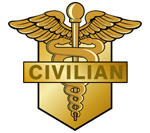
Major Kenneth M. Koyle
AMEDD Center of History and Heritage
9 March 2011
Page 2
Page 3
Page 4
Page 5
Page 6
Page 7
Page 8
Page 9
Page 10
Civilians have played a vital role in Army medicine from the very beginning. In fact, virtually all medical functions were provided by civilians in the first few decades of the Army’s existence. The history of civilian support to the Army Medical Department (AMEDD) is an integral and inseparable component of our overall medical history.
On 27 July 1775 the Continental Congress established a medical department to provide care for the nascent Continental Army. Although it outlined a rudimentary system of care for the military, the legislation creating the medical department did not designate military rank for medical personnel, nor did it specify the correlation of the department to the larger army. This ambiguity left a corps of pseudo-civilian medical providers to carve out their own place in the Army structure, and spawned counterproductive infighting and confusion that persisted throughout the American Revolution and the subsequent War of 1812.
Despite the challenges of working in this ill-defined system, the civilian cadre of the early AMEDD made significant strides in planning and organizing battlefield medicine, preventive care, and basic logistical support for the Army. Under the purview of a Director General (antecedent of the Surgeon General), the surgeons, assistant surgeons, apothecaries, and purveyors worked tirelessly to overcome obstacles and provide the best care possible. These personnel served in a peculiar, indeterminate state—not exactly soldiers, because they had neither rank nor uniforms, but not exactly civilians, because they were subject to the rules, regulations, and restrictions of the Army. Their pay was meager and the conditions of service were arduous. According to one surgeon who served on the Canadian frontier during the War of 1812, most medical men were only willing to serve for a single year in these circumstances, and then only because of curiosity and a thirst for adventure.1
In 1818 Congress finally established a permanent Medical Department with a Surgeon General at its head, although neither he nor the surgeons and assistant surgeons under him held military rank. By 1840 the military surgeons had a standardized uniform and their pay was approaching that of the line officers. Although they were commissioned, they still held no military rank and were not entitled to salutes. This indistinct status was clarified in February 1847, when Congress granted official rank to medical personnel. From this point forward there would be a distinction between the military surgeons and their civilian colleagues, but their roles would often merge and their military functions were frequently indistinguishable.
The contract surgeon was the most prevalent manifestation of civilians serving the AMEDD in the 19th century. These civilian doctors were hired to fill shortages throughout the medical system, often with service at isolated frontier posts or other austere locations. Field commanders were authorized to hire contract surgeons as needed to provide adequate medical care for their units. Their numbers rose steadily over the ensuing years, and during the Civil War
1 Letter, Mann to Tilton, quoted in Harvey E. Brown, Medical Department of the United States Army (Washington: Surgeon General’s Office, 1873), p. 93.

